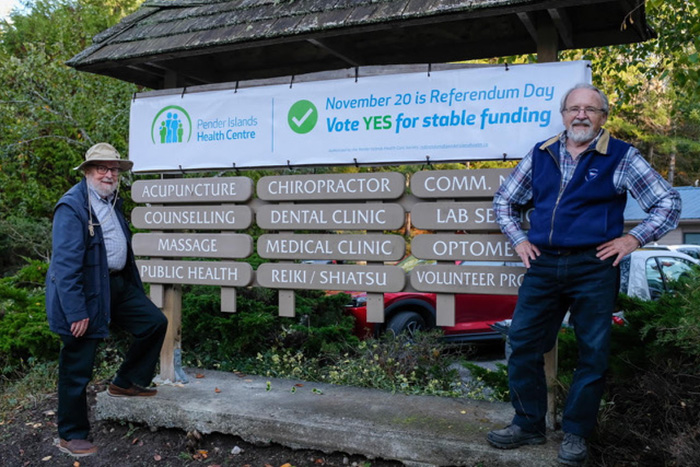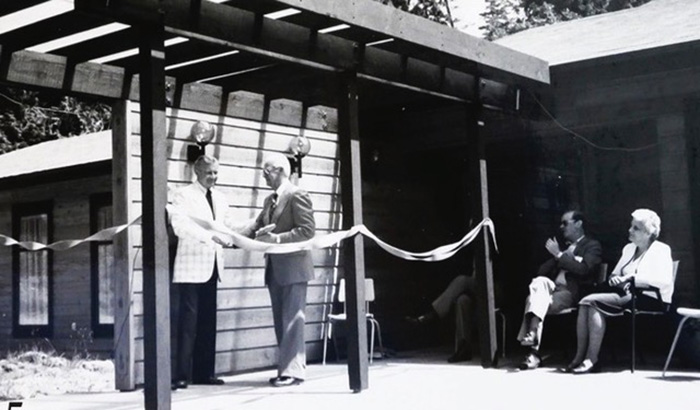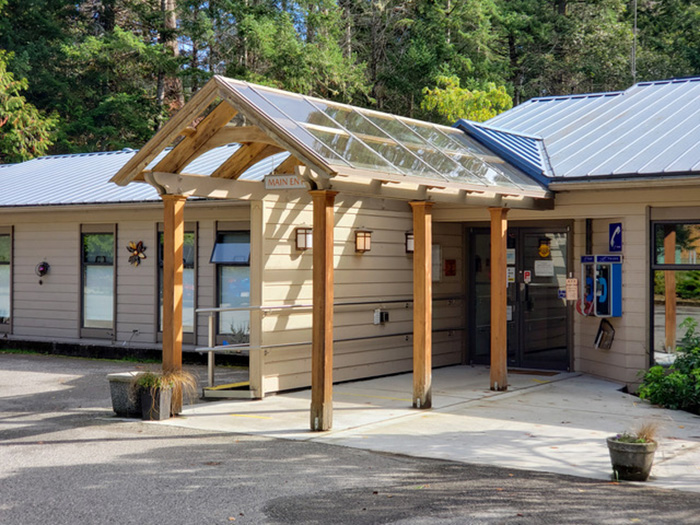As of 2022, Pender Islands Health Centre will have stable funding to keep operating after a referendum gave a resounding yes to fund its operations through property taxes.
A total of 791 people from both North and South Pender islands voted in favour and 142 against in the Nov. 20 referendum. With the referendum passed, the Capital Regional District (CRD) can now raise a maximum of $235,000 per year to fund the centre, which works out to an average of $95 extra per household based on the assessed value of a home being $530,000.
With yes votes amounting for 84 per cent in a referendum that saw 39 per cent of eligible voters cast their ballots, board member with the Pender Islands Health Care Society Simone Marler said this is pretty clear support for moving to this form of funding. The society manages the health facility, as well as advocating, engaging with the community and seeking out and managing funding.

Having a year-round healthcare facility funded in part by property taxes is a long way from where healthcare on the Penders began, “with a rowboat and a midwife named Mrs. Bennett, who travelled by her own muscle power from Mayne Island to welcome new lives to the island,” as the society’s Kathleen Lightman wrote in a history of the health centre.
Doctors first attended from neighbouring Salt Spring Island, many of whom would also row themselves over for emergency calls with rowboats that served as the islands’ first water ambulances. In the 1970s the Penders got their own resident physician, Dr. Homer Rogers, who practised from his home. Wanting to retire, Dr. Rogers and the community could only convince a physician to come to the island if they had a clinic.
The Bishop Coleman Memorial Health Care Centre opened in 1981, nine years after the Lions Club came together and formed the society to keep alive Bishop Michael Coleman’s dream for a health centre on Pender. After extensive community fundraising, getting grant funding and a land donation, the health centre opened in May and the Penders would from that point on never be without a resident doctor.


The centre started with a medical clinic, dentist office and other offices for healthcare providers. By 1989, an ambulance station was built beside the centre. In 1994, a new wing was opened to house home support and alternative therapies.
In 2008 the facility doubled in size, adding a new medical wing, urgent treatment room and renovations to the existing facility. The $1.4-million upgrade was funded by over $700,000 from the community, just under $600,000 in the form of a Capital Regional District (CRD) grant and $142,000 from Island Health.
Now housing over 20 health services, including a medical clinic, dentistry, massage therapy, optometry, homecare and pharmacy, the centre sees around 17,000 visits and appointments per year for a population of 2,300 residents.
Around 40 per cent of North and South Pender residents are over the age of 65, Marler noted, compared to 17 per cent for Canada.
“The complexity of care is much different here, older people need more complex care,” she said.
Care is also integrated at the health centre, Marler added, with visitors able to access the various services “just down the hallway” from one another.
Now 41 years old, the health centre is in need of upgrades to its generator, HVAC and septic systems, as well as major upgrades to bring the building up to code with accessible washrooms, fire codes and more. The society estimated fixing all of this would cost around $800,000 over the next five years.
The stable funding to be collected by the CRD starting next year will be used to operate the centre and free up donation and grant money for repairs and renewals, Marler said.
Funding for the health centre is multifaceted. Money from the B.C. government, through Island Health, goes to funding staff that work in the centre’s clinic, including a nurse practitioner, public health nurse, community health nurses, two full-time physicians as well as the space used by these practitioners. Grants from Island Health fund some lab services, as well as part-time mental health and community support workers. Some community programs are also funded by grants from taxes.
Missing from all of this is costs of operations, which were an estimated $400,000 in 2021. Even with around half of this offset by rental income and grants, a deficit of $215,000 remains.
In the past the centre relied on local support to the tune of around $30- to $40,000 and a whopping $750,000 raised for the 2008 revamp, Marler said. Yet with an aging building, costs are set to rise and the need for donations will be around $150,000 to $200,000 per year.
In 2020 the society began researching funding options. There was little to no appetite for provincial funding for operating the health centre, the society found, and capital funding via the CRD’s hospital district was not possible as the health centre is not a designated health facility, “mainly because the building does not meet current health facility building codes,” said Marler.
After looking at a variety of options to fund solutions to these challenges, the society decided a property tax levy was the best way to ensure funding was stable and long term, and the only way to get funding by 2022. Previously, the society said it relied on the generosity of islanders for funding yet “as important as these will continue to be, donations do not provide guaranteed income.”
Using a property tax levy to fund this service is something Saturna and Galiano islands have also done, in 2017 and 2014 respectively.
“Galiano’s and Saturna’s success on going on the tax roll also encouraged us,” the society wrote. “The other options would take years of discussion with no certainty of success.”
The society had a booth at the farmers market all summer where they heard concerns from residents about the long wait for a family doctor or nurse practitioner, as well as their concerns around limited times for lab services. These are both things the society is advocating for and looking at, Marler said, adding that in the case of attracting and retaining doctors, having the health centre in optimal shape is a key factor.

